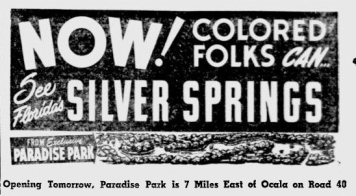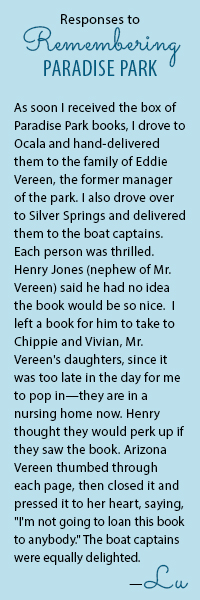 The Segregated Story of the State’s Most Famous Spring
The Segregated Story of the State’s Most Famous Spring
Written by Lu Vickers, coauthor (with Cynthia Wilson-Graham) of Remembering Paradise Park: Tourism and Segregation at Silver Springs
After writing several books on vintage Florida tourist attractions, I considered writing one on the grandmother of them all—Silver Springs. But Paradise Park, the segregated attraction Silver Springs’ owners opened in 1949, got hold of me and wouldn’t let go. I first came across a photo from Paradise Park when doing research on Weeki Wachee: a group of African Americans stood next to a bus, holding up bumper stickers that said “See Silver Springs from Paradise Park.” At that time I thought I might write a book about the racist imagery on postcards, contrasting it with positive images such as the Paradise Park photo. I’ve always been troubled, not only by the misrepresentation of people of color in Florida, but also by the lack of historical information on the contributions African Americans made to Florida tourism.

When I began researching Paradise Park, I discovered that Cynthia Graham also wanted to write the history. I contacted her and we decided to work together. Cynthia shared materials she’d gathered, from postcards to interviews. She put me in contact with boat captains Roosevelt and David Faison, Oscar Collins and Virginia Ferguson. I interviewed them at Silver Springs and they gave me the names of other captains. From there, the project took off.

At a Black History month event in Ocala I met Sylvia Jones, an amazing storyteller whose uncle, Eddie Vereen, managed Paradise Park. Sylvia graciously took me to the original Vereen home, where I interviewed Henrietta and Vivian, Mr. Vereen’s daughters. Sylvia, her brother Henry Jones, cousin Arizona Vereen-Turner, and Reginald Lewis, Mr. Vereen’s grandson, provided me with invaluable photographs and information about Paradise Park’s history, and gave me insight into what a great man Eddie Vereen was. I dedicated the book to Mr. Vereen and his family.

I found photos and audio interviews of two of Silver Springs’ first boat captains at the Florida Archives and transcribed them. Scrolling through the comments section on a blog written about Paradise Park by journalist Jenny Hammer for the Ocala Star Banner, I found Samuel Crosby and his sister Naomi. Their uncle James Glover handled snakes with Ross Allen at Silver Springs and Paradise Park. Samuel and Naomi’s stories about their uncle and his legacy are a testament to the power of nature and science. I also emailed people I thought might have gone to Paradise Park, such as Tampa Bay Times columnist Bill Maxwell. Bruce Mozert, who pioneered underwater photography at Silver Springs, graciously provided me and Cynthia access to his archives. I had finished the book when I received a message from Marsha Phelts, author of An American Beach for African Americans. She recognized Dr. Faye Gary and Dr. June Gary Hopps in a photograph and put me in touch so I was able to include at least a snippet of their remarkable story.

 Florida wasn’t alone in prohibiting access to natural resources, so I also looked outside the state to the segregated tourism that existed all across the country. I discovered that in Chicago in 1919, an African American boy was drowned because he accidentally crossed the color line in Lake Michigan. I found a photo of Martin Luther King, Jr. on a New Jersey beach in the John Mosely Collection at Temple University; I found a photo of the Cuban Giants baseball team at the National Pasttime Museum and a photo of children at Highland Beach at the National Museum of American History. As in other places, Florida’s African Americans often risked their lives seeking to enjoy the beaches. Dr. Von Mizell who fought for the creation of a “colored beach” in Broward County was the target of death threats by the KKK.
Florida wasn’t alone in prohibiting access to natural resources, so I also looked outside the state to the segregated tourism that existed all across the country. I discovered that in Chicago in 1919, an African American boy was drowned because he accidentally crossed the color line in Lake Michigan. I found a photo of Martin Luther King, Jr. on a New Jersey beach in the John Mosely Collection at Temple University; I found a photo of the Cuban Giants baseball team at the National Pasttime Museum and a photo of children at Highland Beach at the National Museum of American History. As in other places, Florida’s African Americans often risked their lives seeking to enjoy the beaches. Dr. Von Mizell who fought for the creation of a “colored beach” in Broward County was the target of death threats by the KKK.
Some of my favorite photos of Paradise Park were sent to me by people like Alice Rozier, who came across several images of her family at the park after her mother passed away. Ms. Rozier said she laughed when she saw how dressed up her family was. In one photo her brother and sisters stand in front of a Paradise Park sign; in another—the one Ms. Rozier favors—she, her sisters and a cousin sit at her mother’s feet. Their father was away serving in the U.S. Air Force. These photos of a family enjoying Paradise Park sum up the feeling that everyone expressed about Eddie Vereen’s kingdom: “Paradise Park will always be in our hearts and minds.” In putting together the voices that make up this book, Paradise Park entered my heart and mind for good as well.
Lu Vickers is the author of Cypress Gardens, America’s Tropical Wonderland: How Dick Pope Invented Florida and the novel Breathing Underwater. She is coauthor of Weeki Wachee Mermaids: Thirty Years of Underwater Photography.

Excellent book by Lu Vickers and Cynthia Graham-Wilson and I’ll be always grateful what they’ve accomplished with their Book about Paradise Park. The pages came to life as I remember many of the people she quoted especially the narrative about my Uncle James” Unlce Son” Glover with his snakes displays. I learned so much from him and thankful to see the history of Paradise Park even with the challenges of that era… it’s still part of my Florida hertiage.
I appreciate you keeping Florida alive. In Texas I passed on the history of Harry T. Moore through young child encarsarated in a prison for children through the leadership of the Bush legacy. Harry should have been the poster child for NAACP. I became the teacher of one of Harry’s descendents to keep his mind engaged until former Governor Rick Perry and the Bush coalition let him out of this prison for children. Harry like me was a teacher who supports the right to vote. I work as an election judge and continue to teach. Read books.
I started the research on Paradise Park in 2005 after seeing a vintage image displayed at Howard Academy Community Center (formerly Howard Academy School for Minorities). Partnering with the community center, community leaders, volunteers, Bruce Mozert and Lu Vickers helped to bring the book to life.
I’ve read Lu Vickers other books on Florida and this one is as good as those–really engaging writing. I like how she described adding those special sections into the book after it was written–those little sections were so moving–the photos of the Rozier famiy were so beautiful. The story of the Gary family was inspirational as well–four Ph.D.s and a brother who still runs the family farm!!!. Great job Lu and Cyntia!